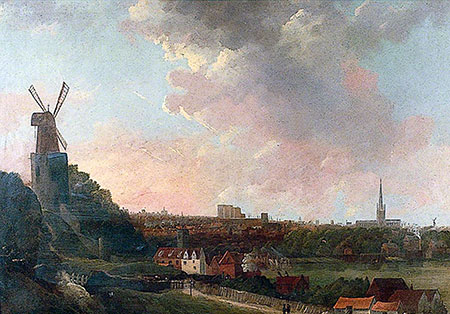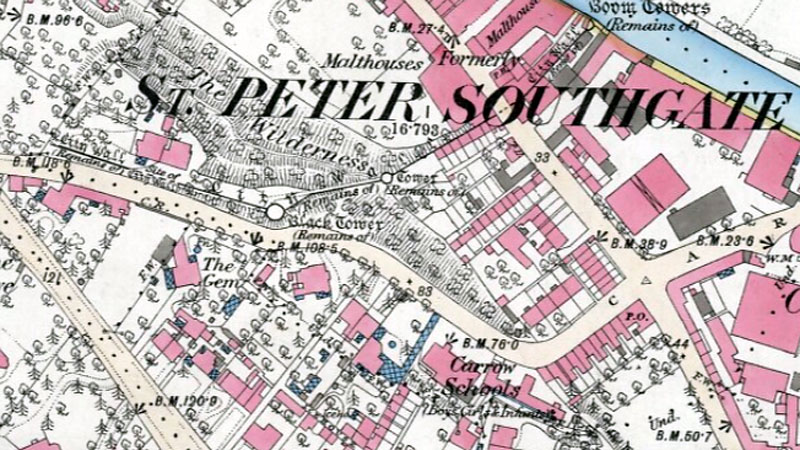
|
Carrow Hill
Black Tower smockmill |
 |
|
John Ninham painting c.1780 |
|
Carrow Hill
smockmill was erected on Black Tower, one of the towers of Norwich
city walls. |
|
From the above painting, it can be seen that mill was a decagonal, horizontally boarded, tapered smock mill, painted brown, with a tall domed cap topped by a weathervane. An extension at the rear housed a large wheel for winding by an endless chain that hung down. It had four common sails but no windows or doors are shown. The mill itself probably only contained a vertical shaft for driving the snuff milling and succeeding cotton spinning machinery housed in the Black Tower itself. If the diameter of the top of the tower were estimated at 25ft., the mill would have been about 17ft. diameter at the base and about 30ft. to the top of the cap, with the sails spanning some 50ft. No doubt part of the top of the tower formed some kind of stage, or setting the sails would have been somewhat precarious. |
|
Tobacco, introduced here in the 16th century, was at first used solely for smoking, but later also for chewing and making snuff. Before the imposition of tax on tobacco under James I, the kiln dried leaf had been used in snuff making, but as the tobacco became dearer, the leaf waste, veins, stems and roots were also utilised. For making snuff then by hand the whole plant was bound up and after having been dried in an oven, it was powdered by means of an iron rasp. This rasp, the Snuffmakers' or Snuffmen's chief tool became their trade sign, often being combined with a crown. When the introduction of machinery became possible, the rough material, after being dried, was crushed in large elm bowls, sometimes copper lined, by means of edge-roller Peak stones, 4 ft. in diameter and 1 ft. thick. After a batch had been crushed, it was sifted and what remained in the sieve was subsequently reground with a later batch. Later machinery consisted of smaller, fixed, wooden mortars with wooden pestles of which a dozen or so could be driven off one great spur wheel. Wolfed Henry Prentis - The Snuff-Mill Story - 1970 |
|
To be SOLD or LETT And entered upon immediately THE WILDERNESS with the Tower and Long Room thereupon, near Bear Street Gates in Norwich, late in the occupation of Samuel Stebbing. Enquire of Mr. Lubbock in the Hospital Yard, Bishopsgate Street, Norwich. Norfolk Chronicle - 24th February & 3rd March 1770 |
|
Joseph Hammond Several Years Butler to the late Rev. Henry Stebbing, D.D. and after to C. Buck Esq. has opened that well known and admired Spot out of Bears Street Gates called THE WILDERNESS or Mackrell's Tower, which from its situation takes in the most beautiful and extensive Views of the City and County . . . Tea, Coffees . . . wines etc. Norfolk Chronicle - 10th April 1773 |
|
To be SOLD or LETT, all that Piece of Pasture and Garden Ground, planted with a Variety of Forest and other Trees, commonly called the WILDERNESS, with the Tower and other Buildings thereon erected, delightfully situated within the City Walls near to Bear Street Gate, and commanding a very beautiful and extensive Prospect, Leasehold of the Corporation of Norwich for a Term of 100 Years granted in the Year 1748. For particulars enquire of Mr. Alderman Gay, or of Mr. Wright, Appraiser, St. Martin's at Palace, in Norwich. Norfolk Chronicle - 9th May 1778 |
|
The reference to other Buildings thereon erected would have only referred to the windmill. The Wilderness was for auction again in August 1779. |
|
THE WILDERNESS
To be SOLD by AUCTION, by Mr. WILLIAM CHASE, At his Auction Room, the Back of the Inns, on Saturday August 7, between the hours of Four and Six in the Afternoon. |
| ALL that Piece of Pasture and Garden Ground, planted with a Variety
of Forest and other Trees, commonly called the Wilderness, with the Tower
and other Buildings thereon erected, delightfully situated within the City
Walls near to Bear Street Gate, and commanding a very beautiful and extensive
Prospect, Leasehold of the Corporation of Norwich for a Term of 100 Years
granted in the Year 1748. Norfolk Chronicle - 31st July 1779 |
|
TO BE SOLD BY AUCTION |
On Thursday, the 17th day of April, 1800, at Three o'clock in the afternoon,
at the Angel Inn, in the Market-place, Norwich, in One or more Lots, by
order of the Assignees of Mr. WILLIAM WHITE, a Bankrupt. AN ESTATE called the WILDERNESS, most delightfully situated without Ber-street Gates, in the City of Norwich and commanding a most beautiful and highly picturesque prospect; consisting of a very good Dwellinghouse and about four acres of Land and Garden Ground, in the occupation of the Rev. Stephen Webster - also of a new erected Tenement and Garden, in the occupation of Charles Bevis - And an excellent Tower Wind Mill, with Work-rooms, Spinning-shops, and Buildings belonging, late in the possession of Mr. William White, and wherein his cotton Manufactory was carried on. Also a Dwelling-house situate next the road leading to Bracondale, with the Buildings and Ground thereto belonging, now in the occupation of Abraham Watson, Cow-keeper. The Premises are leasehold of the Corporation of Norwich, For further Particulars apply to Mr. Ganning, or Mr. Grand, Attorney, St. Gile's-street, Norwich. Norfolk Chronicle - 12th April 1800 |
|
To be RENTED immediately, |
A TOWER WINDMILL, lately used in the manufacturing of Cotton, with
the Tower on which the Mill is situated; and an extensive range of Offices
lately used as spinning rooms. Also to be rented at Michaelmas next, a large GARDEN, well planted with fruit trees, asparagus, strawberry, and raspberry beds; a shrubbery is annexed, and an alcove, with an elevated terrace walk, commanding an extensive and delightful prospect of the city, the river, and adjacent country. Enquire of Mr. T. Greeves, St. Michael's Bridge, Norwich.. Norfolk Chronicle - 10th May 1800 |
|
The painting A panoramic View of Norwich by John Ninham c.1780 shows a close-up view of the Black Tower with its windmill in the foreground, with the Castle and Cathedral in the distance. |
|
A watercolour by an unknown artist, painted after 1810, by which time the old Carrow Bridge had been built nearby, shows the Black Tower surmounted by a small wooden tower without any sails. James Starke and John Thirtle show the mill in a similar state in other paintings. |
|
The mill and machinery had been removed by 1833, when the Black Tower with its thatched roof and flagpole was struck by lightning and burnt out on 7th July that year. |
|
During a severe thunderstorm 'a fire ball apparentl;y about the size of a man's head' fell upon the thatched roof of the Black Tower, Butter Hills, Norwich. The middle and lower rooms occupied by a person named Brooks and the upper storey where a society of artisans assembled for astronomical observations, were entirely consumed. The society's valuable apparatus were destroyed. Norfolk Chronicle - 7th July 1833 |
|
No. 9 Butter Hills, Norwich Plate IX Shows Black Tower with a small building on its roof. This could have been a very small windmill, but the source of the power used in the mill is not really known for certain. Jane Thistlethwaite, The Etchings of E. T. Daniel - 1974 |
| The building would have been the mill after the sails had been removed. |
|
Something to sneeze at |
Having finally sorted out the fact that there were two towers in Bracondale, Norwich, I am now indebted to Mr. Harry_Apling, of Swanton Grove, Dereham, for some further information on the Black Tower. Known as "Blak Toure" in the 15th century, it was one of several of the City Wall towers let out on lease by the corporation. It was also known as the Snuff Tower because in 1783 it was occupied by Walter Livingstone, snuffmaker and tobacconist of No. 52, Market Place, and the "Snuff Mill at the Wilderness." Mr. Apling tells me that a painting in the Castle Museum, believed to be by John Ninham about 1780, shows the tower surmounted by a wooden smock mill which evidently drove the snuff making machinery. By 1800 snuff milling had ceased, and the windmill had "lately" been providing power for a cotton spinning mill. Clement Court, Eastern Daily Press - 12th September 1981 |
 |
O. S. Map 1883 |
|
February 1770: Black Tower and The Wilderness advertised for sale or let |
If you have any memories, anecdotes or photos please let us know and we may be able to use them to update the site. By all means telephone 07836 675369 or
|
|
Nat
Grid Ref TG23750762
|
-1778
to 1810+
|
|
| All
historical material within this page © Michael Roots & Jonathan Neville |
Top of Page | Web
design and website © Jonathan Neville, Norfolk Mills 2018 |